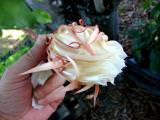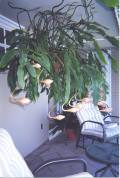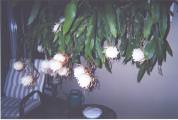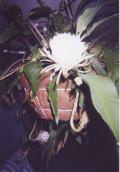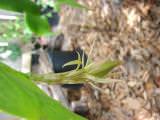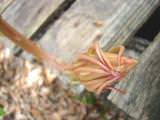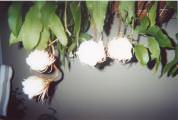This plant may be available to buy
Click the banana to see

|
Night Blooming Cereus click pic to enlarge |
|
Zone 9-10-11 There is immense confusion and mis-information about what is the true Night Blooming Cereus and what is the correct Latin for Night Blooming Cereus Frankly, we have never seen such a disarray of statement and opinion regarding any plant Searching the Internet via GOOGLE, we see many other Latin names referring to Night Blooming Cereus. For example, the Texas Cactus Council lists 4 Latin names for Night Blooming Cereus: Cereus jacamaru, Epiphyllum oxypetalum, Selenicereus grandidflorus and Hylocereus undatus. The Cactus and Succulent Society of America lists Cereus jacamaru for the Latin. A page from UCLA claims Epiphyllum oxypetalumis is correct In addition, we see Cereus peruvianus and Peniocereus greggii listed at normally reputable websites (not plant forums which are frequently grossly unreliable). Even commercial growers, normally scrupulous about correct Latin, are seen using Epiphyllum oxypetalum, Cereus peruvianus and other Latin names for Night Blooming Cereus Bottom line, we go Epiphyllum oxypetalum, but that's not as important as knowing about this plain-looking plant with extraordinary blooming performance So what's all the fuss? The fuss is that Night Blooming Cereus, Epiphyllum oxypetalum, is a really cool semi-eipiphytic plant with aerial roots from Mexico that grows to impressive proportions with spectacular blooming performance click pic to enlarge Our 3 Night Blooming Cereus plants are in hanging baskets as well (cuttings from the plant above) providing very little soil, a super well-drained soil mix, and fed occassionally with time release pellet food . Baskets we use are shallow (roots of Night Blooming Cereus are very shallow and few) and wide. A large plant as pictured above and below would need a deeper basket, here, lined with palm fiber to hold the soil, roots and plant click pics to enlarge In South Florida zone 10, there is no growth during the winter months. Come spring, suprisingly quick growth is seen to produce flower stalks, but not so much foliage growth. Foliage tends to get going after blooming periods in summer and fall. Leaf growth seems, as one would expect, during fall months. Remember, this is an eipiphytic plant so atmospheric absorbtion of nutrients is the feeding method/system in the wild Once your Night Blooming Cereus plant starts developing blooms , you have to be watchful of progress so you can set your alarm clock to wake up and be there for the finale, often after midnight and certainly before dawn, when the final flower opening sequence occurs. Be there at the right moments and you will see movement/motion as the flower fully blooms, opening before your eyes. Here are pics of Night Blooming Cereus flower development When you see a flower like the 3rd picture, set your alarm clock click pics to enlarge click pic to enlarge
Reading this article, by now you want a Night Blooming Cereus plant of your own, right?
click pic to enlarge |
